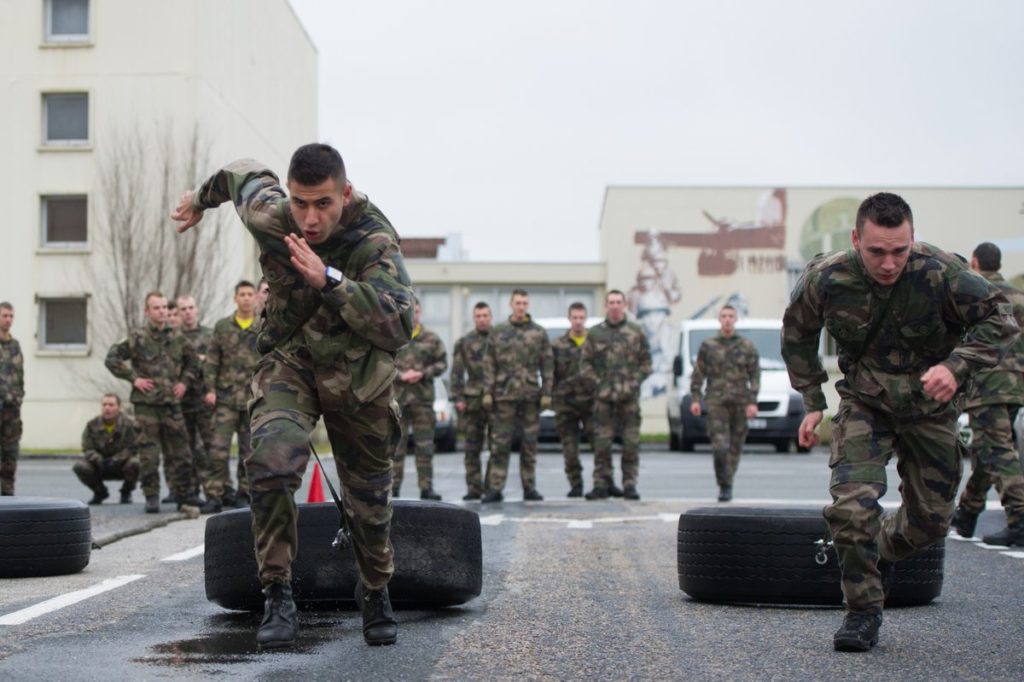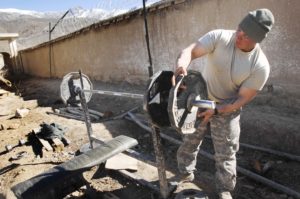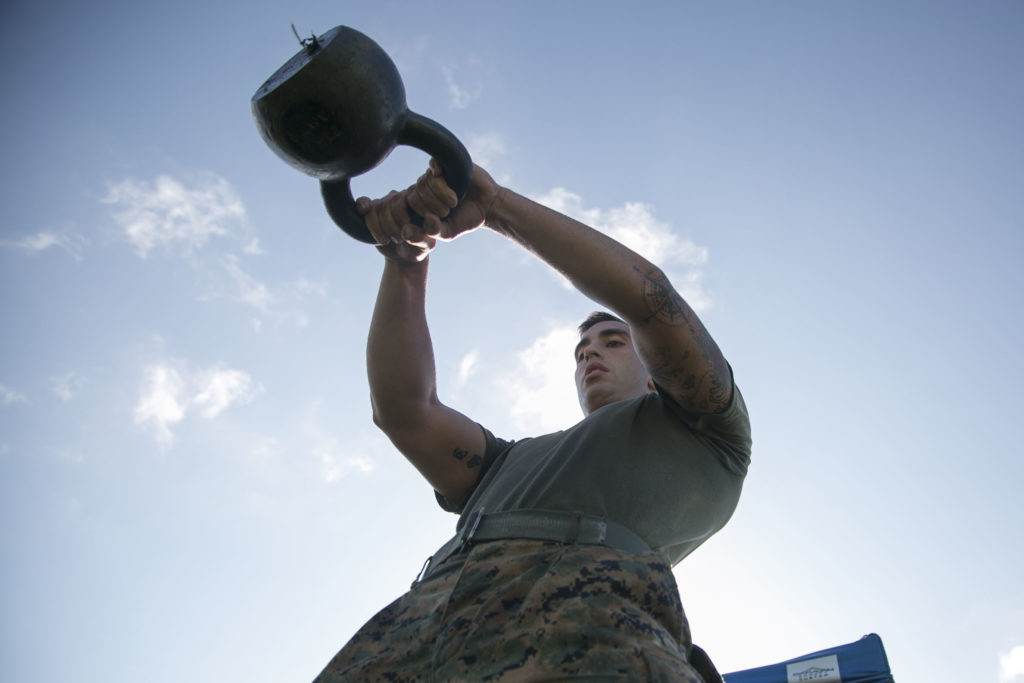MILITARY WORKOUT : KETTLEBELL, THE ULTIMATE TOOL
The kettlebell, the best tool for military training?
Military training is a crucial element for armed forces personnel, as they are often exposed to extreme conditions in the field. Being physically prepared is essential to ensure the safety and success of missions.
In this article, we’ll take a detailed look at the importance of military physical preparation, the benefits it offers, the basics to follow, the most effective training methods, precautions to take, and strategies to maintain optimal physical condition.
We will also explain the different components of military training, including endurance, strength, power, agility, speed, flexibility, and balance, and their importance in military operations.
Finally, we’ll discuss the benefits of kettlebell workouts for military physical preparation. Indeed, the kettlebell is a practical and effective tool, particularly well suited to military training.
Benefits of military training
Good physical preparation offers many benefits for the military, both in terms of performance and health. Here are some of the most important benefits :
Improved performance in the field
Good physical preparation allows soldiers to better meet the physical demands of the missions entrusted to them. It increases stamina, strength, power, agility, speed, flexibility, and balance, allowing service members to better perform required physical tasks.
Reduced risk of injury
Good physical preparation reduces the risk of musculoskeletal injuries, which can compromise the unit’s safety and ability to carry out its mission. Members who are in better physical condition are less likely to sustain injuries while performing physical tasks, such as carrying heavy loads or walking over rough terrain.
Reduced fatigue
Good physical preparation helps soldiers better tolerate fatigue and recover more quickly after intensive physical activities. Members who are in better physical condition are able to sustain a higher level of exertion for a longer period of time, which reduces fatigue and improves performance.
Improved overall health
Good physical preparation provides general health benefits for service members, reducing the risk of cardiovascular disease, diabetes, obesity and other health problems associated with physical inactivity. Members who maintain good physical condition are also more resistant to infectious diseases and have a better overall quality of life.
Good physical preparation is therefore essential for the military, as it improves their performance in the field, reduces the risk of injury, reduces fatigue and improves their overall health.

Principles of military training
To achieve the best results in military physical preparation, it is important to follow some key principles. The following principles are essential for the physical preparation of soldiers :
Specificity
Physical training should be specific to the mission requirements and the physical tasks the military must perform in the field. For example, endurance training would be more appropriate for long-duration missions, while power training would be more useful for missions requiring explosive force.
Progressive overload
To achieve performance gains, service members must progressively overload their bodies. This means gradually increasing the intensity, duration or frequency of training, while allowing the body to recover adequately between sessions.
Individualization
Every soldier is different and has different physical needs. It is therefore important to personalize the training according to the individual objectives, needs and physical limits of each person.
Variation
To avoid stagnation and maximize performance gains, it is important to vary training by using different types of exercises, training modalities and training methods.
By applying these key principles, soldiers can ensure that their physical training is appropriate to the demands of their mission, that it is safe and effective, and that it maximizes their performance gains.
Components of military training
Military physical preparation consists of several key elements that are necessary to optimize performance in the field. Here are the seven main components :
- Endurance : Endurance is the ability to sustain prolonged physical activity without excessive fatigue. In military operations, endurance is essential for long marches and long patrols.
- Strength : Strength is the ability to produce muscle force. It is needed for lifting and carrying equipment, but also for more physical tasks, such as hand-to-hand combat.
- Power : Power is the ability to produce force quickly. It is important for explosive movements, such as sprints, jumps and combat movements.
- Agility : Agility is the ability to change direction quickly while maintaining balance. It is essential for combat situations, where speed of movement is crucial.
- Speed : Speed is the ability to move quickly over a given distance. It is necessary for pursuit of an enemy or for evasion.
- Flexibility : flexibility is the ability to perform movements with a large amplitude. It is important to reduce the risk of injury and to improve the overall quality of life.
- Balance : Balance is the ability to maintain stability during complex movements. It is needed for combat situations and for physical tasks, such as climbing or traversing rough terrain.
Each of these components is important for the physical performance of soldiers in the field, and physical training must be adapted according to the requirements of the mission.

The kettlebell for military training
Members of the military have very high physical demands and must be able to adapt quickly to different environments and situations. The kettlebell is an ideal physical preparation tool for the military because it offers many specific benefits to their training.
A functional tool
First of all, the kettlebell allows you to perform functional training. Kettlebell movements often involve several muscle groups at the same time, which is very close to the reality of the movements and tasks that the military performs in the field. Functional workouts help improve coordination and balance, as well as overall strength.
An effective tool
Also, the kettlebell is very effective in improving strength and stability. Kettlebell exercises often involve ballistic movements, which are particularly useful for building strength and power. Stability is also improved as kettlebell movements require increased muscle activation to maintain a stable position and avoid injury.
The kettlebell can also help the military prevent injuries. Kettlebell movements often involve a large amount of work with the posterior chain muscles, such as the glutes and hamstrings. These muscles, often overlooked in traditional training programs, are essential for preventing injury and maintaining good posture.
An adaptable tool
Also, the kettlebell is very adaptable to all fitness levels. The movements as well as the weight of the kettlebell can be adjusted according to the ability of the individual, making it an ideal physical preparation tool for beginners and advanced athletes alike. Kettlebell workouts can also be done in a group or individually, which allows great flexibility in terms of scheduling and training follow-up.
A portable tool
Finally, the kettlebell is very easy to transport and use in the field. Service members can easily take a kettlebell with them on the go, allowing them to continue their training wherever they are. The kettlebell does not require a lot of space and can be used in any situation, making it a very practical physical preparation tool for the military.
Our OneBell® modular kettlebell is particularly well suited to operational physical preparation. Adjustable from 12 to 32kg in 1kg increments, it is very versatile and compact, making it one of the best tools for military training.
Kettlebell exercises for military training
Kettlebell exercises are many and varied, but some are particularly suitable for the physical preparation of the military. Here are some of the key kettlebell exercises military members should incorporate into their training :
The swing
The swing is the best known and most effective kettlebell exercise for improving the strength and power of the posterior chain muscles. It involves a hip extension to generate force to swing the kettlebell forward, followed by a controlled return to the starting position. The swing can be performed with one or two kettlebells and can be adapted according to the practitioner’s physical condition.
The clean
The clean is another very effective kettlebell exercise for improving strength and power in the posterior chain, core, and forearm muscles. It involves pulling the kettlebell from the starting position on the floor to the chest, in a rack position, using a combination of leg strength and arm pull. The clean can also be performed with one or two kettlebells.
The squat
The squat is a basic exercise for leg strength and stability. With a kettlebell in the chest-high position, the squat can be performed with a wide variety of loads and styles, including the one-legged squat or the goblet squat.
The press
The press is a kettlebell exercise that involves a vertical pushing force from the chest to lift the kettlebell overhead. The press helps strengthen the shoulders, triceps and upper back muscles, as well as core stability.
The turkish get-up
The turkish get-up is a complete exercise that involves a series of movements that develop strength, coordination and stability for the whole body. It consists of a series of movements from a lying position, to a standing position with the kettlebell raised overhead. The turkish get-up is a complex exercise that can take time to master, but has many benefits for military physical preparation.
These key kettlebell exercises are just a few examples of what the kettlebell can offer for military training. They can be incorporated into a more comprehensive training program, which may include other kettlebell exercises or other types of functional training. By using these exercises, service members can improve their strength, power, stability, and coordination, while minimizing the risk of injury and improving their overall physical fitness.

Military training program with kettlebell
Now that we’ve looked at the benefits of the kettlebell and the key exercises for the military, it’s time to talk about workout routines. Kettlebell training programs for the military can be designed in different ways, but the goal is always the same: to improve strength, power, endurance, stability and coordination for successful missions in the field. Here are some kettlebell workout routines military members can consider :
Basic training program
This basic training program includes key kettlebell exercises such as the swing, clean, squat, press and turkish get-up. This program is designed to improve overall body strength, power, stability and coordination. It can be done two to three times a week, with a recovery day between workouts.
Leg training program
This program is designed to improve leg strength and stability by focusing on kettlebell exercises such as the swing, squat, lunges, etc. This program can be done twice a week, with two recovery days between workouts.
Upper body workout program
This program is designed to improve shoulder strength and stability by focusing on kettlebell exercises such as the press and jerk. This program can be done twice a week, with two recovery days between workouts.
HIIT training program
This program is designed to improve overall military fitness using high intensity kettlebell exercises with very short rest times. It can include a combination of exercises such as the swing, clean, squat, and burpees. This program can be done twice a week, with two recovery days between workouts.
These kettlebell workout routines for the military are just a few examples of what’s possible with the kettlebell. Depending on individual needs and goals, other programs can be created using different kettlebell exercises and varying the number of sets, reps and recovery times. It is important to remember that military physical preparation is an ongoing process and training programs should be adapted accordingly.
Other articles you might be interested in :
- GPP for running with kettlebell
- MMA physical preparation with kettlebell
- Football physical preparation with kettlebell
- Abs exercises with kettlebell
- WOD with kettlebell in CrossFit
- Bodybuilding with kettlebell
- Kettlebell exercises for women
- Kettlebell HIIT
- Kettlebell sport : all you need to know
- Tennis physical preparation with kettlebell
- Handball physical preparation with kettlebell
- Rugby physical preparation with kettlebell
- Skiing physical preparation with kettlebell
- Basketball physical preparation with kettlebell
Sources :
- https://www.kettlebellkings.com/blogs/default-blog/blog10-minute-kettlebell-workout-for-soldiers
- https://www.strongfirst.com/hardening-the-soldier-for-combat/

